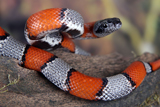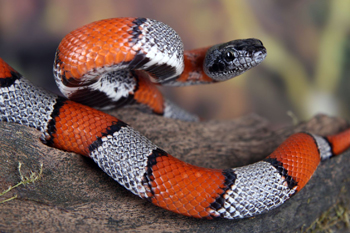Coral Snakes and Their Impersonators

Rainy season is upon us. The foliage is lush, insects, frogs and snakes are moving around looking for food and mates. There are over 130 species of snakes found in Panama and there is still much to be studied about these reptiles. While the Coral snake is not the only poisonous snake around town, it is certainly the one with the worst reputation, possibly because it is difficult to tell the harmless Coral from the poisonous one. There are 11 different species of the Coral snake in Panama - more when you consider the many non-venomous Coral copycats. Corals and Coral mimics can be divided into 3 groups: bicolored (red-black-red), tricolored (red-yellowblack-yellow-red) and tricolored-triad (red-yellow-blackyellow-red). There are no tricolored-triad mimics, perhaps because this is the most evolved of the species.
Corals generally mind their own business, choosing flight over fight when given the chance. A common Coral ranges from 10 to 20 inches in length. One way to differentiate a true Coral from its impersonator is by the size of its eyes. Poisonous Corals have small eyes, whereas the non-threatening variety has larger eyes.
Prevention through the rainy season
Snakes bite when they feel threatened. If you encounter a snake assume it is dangerous. Since coral snakes are especially tricky to identify, your best bet is to leave it alone. If you are nature hiking, using a heavy step will cause the ground to vibrate and will send snakes flee in the other direction. Always wear proper footwear in areas of foliage. Use a flashlight at night. If you’re dealing with a direct encounter remain still and stay calm.
In case of a snake bite:
1. Protect yourself to keep from being bitten again.
2. Stay calm. Agitation will cause your heart to beat quicker; if you are bitten by a poisonous snake, this will cause the poison to spread quicker.
3. Seek medical help immediately. Don’t wait for symptoms to appear before going to a clinic or emergency room.
4. Do not put ice or any cold substance on the bite.
5. If possible keep the bitten area in a functional position below heart level. This will minimize the blood returning to the heart and other organs of the body.
6. Do not eat or drink anything.
7. Do not administer stimulants or pain medication.
8. Remove any items or clothing, which may constrict the bitten limb in case of swelling.
9. Do not cut an ‘X’ over the bite and suck the poison out (like you may have seen on tv).
10. Do not use a tourniquet, instead tie a bandage 2 – 4 inches above the bite (loose enough to fit one finger through). This will slow the blood flow.
When it comes to snake bites, prevention is better than cure. Snakes like to hide in tall grasses and foliage, so keeping your lawn cut will help keep them away.
 |
 |
